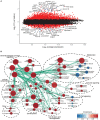Leptin Induces Mitosis and Activates the Canonical Wnt/β-Catenin Signaling Pathway in Neurogenic Regions of Xenopus Tadpole Brain
- PMID: 28533765
- PMCID: PMC5421298
- DOI: 10.3389/fendo.2017.00099
Leptin Induces Mitosis and Activates the Canonical Wnt/β-Catenin Signaling Pathway in Neurogenic Regions of Xenopus Tadpole Brain
Abstract
In addition to its well-known role as an adipostat in adult mammals, leptin has diverse physiological and developmental actions in vertebrates. Leptin has been shown to promote development of hypothalamic circuits and to induce mitosis in different brain areas of mammals. We investigated the ontogeny of leptin mRNA, leptin actions on cell proliferation in the brain, and gene expression in the preoptic area/hypothalamus of tadpoles of Xenopus laevis. The level of leptin mRNA was low in premetamorphic tadpoles, but increased strongly at the beginning of metamorphosis and peaked at metamorphic climax. This increase in leptin mRNA at the onset of metamorphosis correlated with increased cell proliferation in the neurogenic zones of tadpole brain. We found that intracerebroventricular (i.c.v.) injection of recombinant Xenopus leptin (rxLeptin) in premetamorphic tadpoles strongly increased cell proliferation in neurogenic zones throughout the tadpole brain. We conducted gene expression profiling of genes induced at 2 h following i.c.v. injection of rxLeptin. This analysis identified 2,322 genes induced and 1,493 genes repressed by rxLeptin. The most enriched Kyoto Encyclopedia of Genes and Genomes term was the canonical Wnt/β-catenin pathway. Using electroporation-mediated gene transfer into tadpole brain of a reporter vector responsive to the canonical Wnt/β-catenin signaling pathway, we found that i.c.v. rxLeptin injection activated Wnt/β-catenin-dependent transcriptional activity. Our findings show that leptin acts on the premetamorphic tadpole brain to induce cell proliferation, possibly acting via the Wnt/β-catenin signaling pathway.
Keywords: Wnt/β-catenin; Xenopus; leptin; metamorphosis; neurogenesis.
Figures







Similar articles
-
To eat or not to eat: ontogeny of hypothalamic feeding controls and a role for leptin in modulating life-history transition in amphibian tadpoles.Proc Biol Sci. 2018 Mar 28;285(1875):20172784. doi: 10.1098/rspb.2017.2784. Proc Biol Sci. 2018. PMID: 29593109 Free PMC article.
-
Thyroid hormone activates Wnt/β-catenin signaling involved in adult epithelial development during intestinal remodeling in Xenopus laevis.Cell Tissue Res. 2016 Aug;365(2):309-18. doi: 10.1007/s00441-016-2396-8. Epub 2016 Apr 11. Cell Tissue Res. 2016. PMID: 27068920
-
Thyroid Hormone Receptor Alpha Is Required for Thyroid Hormone-Dependent Neural Cell Proliferation During Tadpole Metamorphosis.Front Endocrinol (Lausanne). 2019 Jun 28;10:396. doi: 10.3389/fendo.2019.00396. eCollection 2019. Front Endocrinol (Lausanne). 2019. PMID: 31316462 Free PMC article.
-
Autoinduction of nuclear receptor genes and its significance.J Steroid Biochem Mol Biol. 1993 Aug;46(2):105-19. doi: 10.1016/0960-0760(93)90286-6. J Steroid Biochem Mol Biol. 1993. PMID: 8664159 Review.
-
Genome-wide analysis of canonical Wnt target gene regulation in Xenopus tropicalis challenges β-catenin paradigm.Genesis. 2017 Jan;55(1-2):e22991. doi: 10.1002/dvg.22991. Genesis. 2017. PMID: 28095618 Free PMC article. Review.
Cited by
-
To eat or not to eat: ontogeny of hypothalamic feeding controls and a role for leptin in modulating life-history transition in amphibian tadpoles.Proc Biol Sci. 2018 Mar 28;285(1875):20172784. doi: 10.1098/rspb.2017.2784. Proc Biol Sci. 2018. PMID: 29593109 Free PMC article.
-
Evolutionary conservation of leptin effects on wound healing in vertebrates: Implications for veterinary medicine.Front Endocrinol (Lausanne). 2022 Aug 25;13:938296. doi: 10.3389/fendo.2022.938296. eCollection 2022. Front Endocrinol (Lausanne). 2022. PMID: 36093099 Free PMC article.
-
Lactobacillus rhamnosus GG-induced Expression of Leptin in the Intestine Orchestrates Epithelial Cell Proliferation.Cell Mol Gastroenterol Hepatol. 2020;9(4):627-639. doi: 10.1016/j.jcmgh.2019.12.004. Epub 2019 Dec 23. Cell Mol Gastroenterol Hepatol. 2020. PMID: 31874255 Free PMC article.
-
Leptin attenuates the osteogenic induction potential of BMP9 by increasing β-catenin malonylation modification via Sirt5 down-regulation.Aging (Albany NY). 2024 May 3;16(9):7870-7888. doi: 10.18632/aging.205790. Epub 2024 May 3. Aging (Albany NY). 2024. PMID: 38709288 Free PMC article.
-
Nutrient availability contributes to a graded refractory period for regeneration in Xenopus tropicalis.Dev Biol. 2021 May;473:59-70. doi: 10.1016/j.ydbio.2021.01.005. Epub 2021 Jan 20. Dev Biol. 2021. PMID: 33484704 Free PMC article.
References
LinkOut - more resources
Full Text Sources
Other Literature Sources
Molecular Biology Databases

